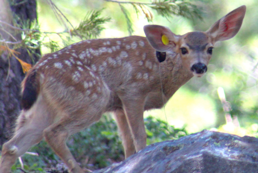
Black-Tailed Deer - Mountain Lion Project


Project Synopsis
The Black-tailed Deer-Mountain Lion Project was launched to determine why harvest rates, and possibly deer populations, have been declining over the last 20 years in some of the state’s best deer habitat. The study investigates the effect of habitat use and selection, predation of fawns and adult does, habitat change over time, and mountain lion kill rates on the black-tailed deer population.
The project has two components: the Black-tailed Deer Project and the Mountain Lion Project
The objectives of the Black-tailed Deer Project are:
-
1)Document habitat use adult females across seasons and a range of predation risk as well as the effects of this habitat use on survival and reproduction in birthing and wintering areas
-
2)Investigate cause specific mortality of adult females and fawns
-
3)Model the effect of long term habitat change and weather patterns on the deer population
The objectives of the Mountain Lion Project are to study:
-
1)The evolutionary function of scrape communication in mountain lion communities
-
2)The effects of mountain lions on the scavenger guild
-
3)The role of public opinion in the management of mountain lions in California
-
4)The kill rate of black-tailed deer by mountain lions in the study area
This study should provide important information for managers to understand the factors in deer population cycles and the role of habitat and predation in the California deer decline, as well as providing insights into the general ecology of black-tailed deer.
Looking for Information on Black-tailed Deer?

Collaborators
David Casady
California Department of Fish & Game (CDFG)
Funding Partners
Associated Publications
Forrester, T., Wittmer, H. A review of the population dynamics of mule and black-tailed deer in western North America. In review.










© 2011 Heiko U. Wittmer All photos copyrighted by authors Original design by Patrick Hilton

